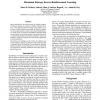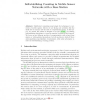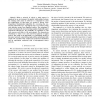33 search results - page 3 / 7 » Probabilistic Modeling of Mobile Agents' Trajectories |
AAAI
2008
13 years 7 months ago
2008
Recent research has shown the benefit of framing problems of imitation learning as solutions to Markov Decision Problems. This approach reduces learning to the problem of recoveri...
PAMI
2010
13 years 4 days ago
2010
We propose a novel approach for activity analysis in multiple synchronized but uncalibrated static camera views. In this paper, we refer to activities as motion patterns of objects...
WDAG
2007
Springer
13 years 11 months ago
2007
Springer
Abstract. Distributed computing must adapt its techniques to networks of mobile agents. Indeed, we are facing new problems like the small size of memory and the lack of computation...
ICRA
2006
IEEE
13 years 11 months ago
2006
IEEE
— When a network of robots or static sensors is emplaced in an environment, the spatial relationships between the sensing units must be inferred or computed for most key applicat...
AAAI
2004
13 years 6 months ago
2004
We present a probabilistic method for path planning that considers trajectories constrained by both the environment and an ensemble of restrictions or preferences on preferred mot...



